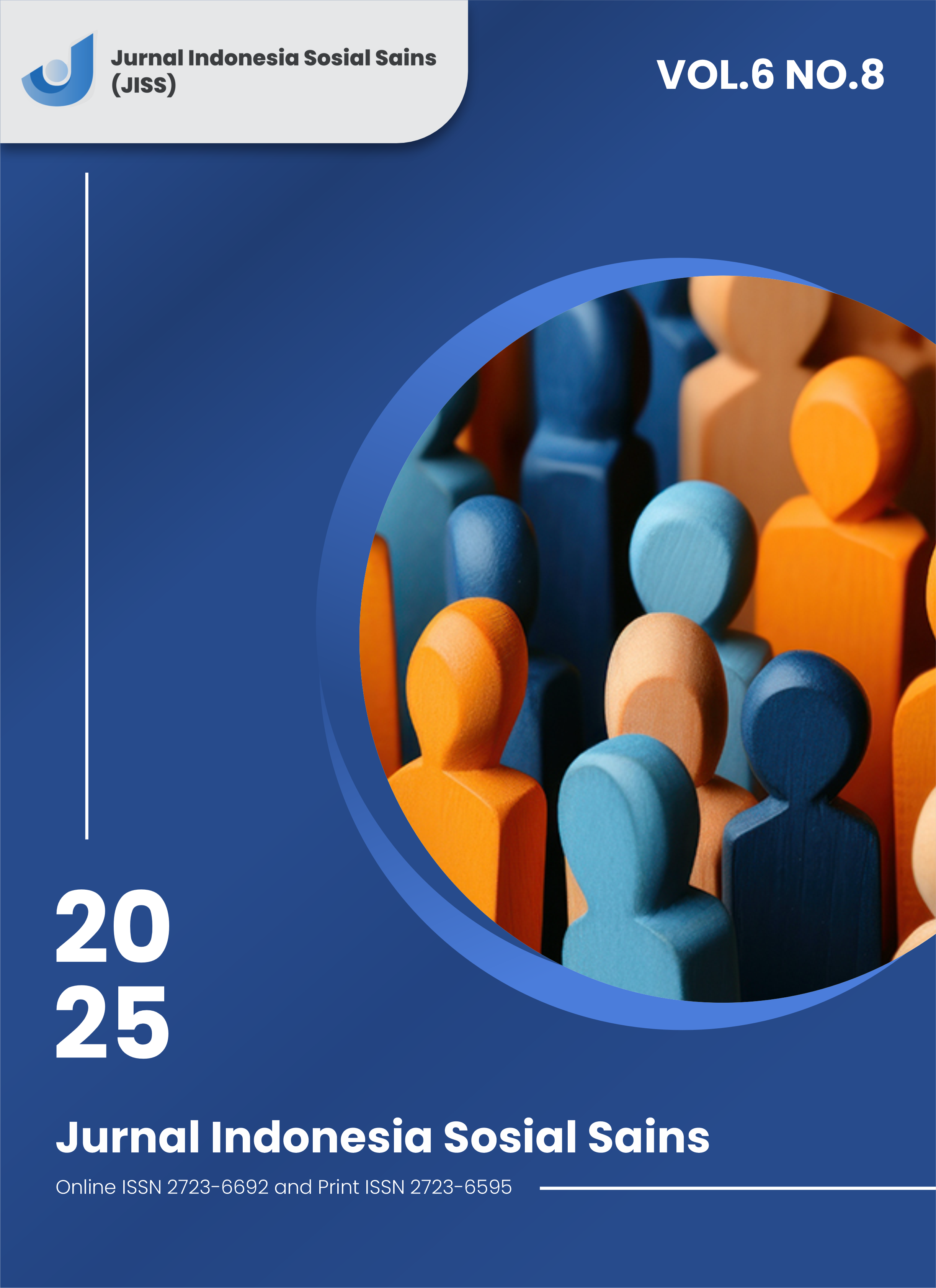Effectiveness of Supportive Therapy in Reducing Anxiety in Adolescents in Sukamaju Village, Purwakarta
DOI:
https://doi.org/10.59141/jiss.v6i8.1858Keywords:
Adolescents, Anxiety disorders, Therapy, Quasi-experimental designAbstract
Anxiety disorders among adolescents have become a significant public health concern, particularly in rural communities where access to mental health services is limited. Supportive therapy represents a viable intervention approach that can be implemented in community settings. This study aimed to evaluate the effectiveness of supportive therapy in reducing anxiety levels among adolescents in Sukamaju Village, Purwakarta. A quasi-experimental design was employed with 60 adolescents aged 12-18 years experiencing anxiety symptoms. Participants were divided into intervention and control groups. The intervention group received 8 sessions of supportive therapy over 4 weeks, while the control group received standard care. Anxiety levels were measured using the Hamilton Anxiety Rating Scale (HAM-A) before and after intervention. The intervention group showed significant reduction in anxiety scores (pre-test: 18.5±3.2, post-test: 12.3±2.8, p<0.001) compared to the control group (pre-test: 18.1±3.5, post-test: 17.2±3.1, p>0.05). The effect size was large (Cohen's d = 2.1), indicating clinically significant improvement. Supportive therapy demonstrated significant effectiveness in reducing anxiety among adolescents in rural community settings, suggesting its potential as a feasible mental health intervention for underserved populations.
References
Adi, P., & Fitriani, D. (2022). Mental health stigma and help-seeking behavior among adolescents in rural Indonesia. Jurnal Psikologi Sosial, 20(2), 115–128. https://doi.org/10.7454/jps.2022.v20i2.105
Barzeva, S. A., Richards, J. S., Meeus, W. H. J., & Oldehinkel, A. J. (2021). Adolescent social anxiety: Developmental trajectories and early risk factors. Journal of Abnormal Child Psychology, 49(3), 321–334. https://doi.org/10.1007/s10802-020-00733-2
Cabral, M. D., & Patel, D. R. (2020). Risk factors and prevention strategies for anxiety disorders in childhood and adolescence. Anxiety disorders: Rethinking and understanding recent discoveries, 543–559.
Hanifah, S., & Wulandari, R. (2020). Cultural barriers in adolescent mental health service utilization in Indonesia. Kesmas: Jurnal Kesehatan Masyarakat Nasional, 15(4), 203–210. https://doi.org/10.21109/kesmas.v15i4.4552
Irmansyah, I., Prasetyo, Y. A., Minas, H., & Midin, M. (2019). Mental health system development in Indonesia. International Journal of Mental Health Systems, 13(1), 1–8. https://doi.org/10.1186/s13033-019-0288-6
Kapoor, I., Sharma, S., & Khosla, M. (2020). Social anxiety disorder among adolescents in relation to peer pressure and family environment. Bioscience Biotechnology Research Communications, 13(2), 923–929.
Kusnandar, V. B., & Paramastri, I. (2020). The prevalence of adolescent mental health problems in Indonesia: Evidence from Riskesdas 2018. Jurnal Psikologi Klinis dan Kesehatan Mental, 9(2), 102–112. https://doi.org/10.20885/psikologiklinis.vol9.iss2.art2
Lipsitz, J. D., & Al., E. (2018). A randomized trial of interpersonal therapy versus supportive therapy for social anxiety disorder. Depression and Anxiety, 25(6), 542–553.
Maharani, A., Tampubolon, G., & Stewart, R. (2022). Inequalities in access to adolescent mental health services in Indonesia. BMC Public Health, 22(1), 1–10. https://doi.org/10.1186/s12889-022-13312-1
Magson, N. R., Freeman, J. Y. A., Rapee, R. M., Richardson, C. E., Oar, E. L., & Fardouly, J. (2021). Risk and protective factors for prospective changes in adolescent mental health during the COVID-19 pandemic. Journal of Youth and Adolescence, 50(1), 44–57. https://doi.org/10.1007/s10964-020-01332-9
Orben, A., Tomova, L., & Blakemore, S. J. (2020). The effects of social deprivation on adolescent development and mental health. The Lancet Child & Adolescent Health, 4(8), 634–640. https://doi.org/10.1016/S2352-4642(20)30186-3
Patel, V., Saxena, S., Lund, C., Thornicroft, G., Baingana, F., Bolton, P., ... & Unützer, J. (2018). The Lancet Commission on global mental health and sustainable development. The Lancet, 392(10157), 1553–1598. https://doi.org/10.1016/S0140-6736(18)31612-X
Polanczyk, G. V., Salum, G. A., Sugaya, L. S., Caye, A., & Rohde, L. A. (2015). Annual research review: A meta-analysis of the worldwide prevalence of mental disorders in children and adolescents. Journal of Child Psychology and Psychiatry, 56(3), 345–365. https://doi.org/10.1111/jcpp.12381
Racine, N., McArthur, B. A., Cooke, J. E., Eirich, R., Zhu, J., & Madigan, S. (2020). Global prevalence of depressive and anxiety symptoms in children and adolescents during COVID-19: A meta-analysis. JAMA Pediatrics, 175(11), 1142–1150. https://doi.org/10.1001/jamapediatrics.2021.2482
Sari, L. P., & Wahyudi, E. (2021). Anxiety disorders among Indonesian adolescents: Trends and contributing factors. Journal of Educational, Health and Community Psychology, 10(3), 457–472. https://doi.org/10.12928/jehcp.v10i3.2199
Shorey, S., Chee, C. Y. I., Ng, E. D., Chan, Y. H., Tam, W. W. S., & Chong, Y. S. (2018). Prevalence and incidence of postpartum depression among healthy mothers: A systematic review and meta-analysis. Journal of Psychiatric Research, 104, 235–248. https://doi.org/10.1016/j.jpsychires.2018.08.001
Steinberg, L. (2012). Cognitive and affective development in adolescence. Trends in Cognitive Science. Handbook of Parenting, 9(2), 69–74.
Tristiana, R. D., Yusuf, A., Fitryasari, R., Wahyuni, S. D., & Nihayati, H. E. (2018). Perceived barriers on mental health services by the family of patients with mental illness. International Journal of Nursing Sciences, 5(1), 63–67. https://doi.org/10.1016/j.ijnss.2017.12.002
Downloads
Published
How to Cite
Issue
Section
License
Copyright (c) 2025 Shinny Ria Pratiwi

This work is licensed under a Creative Commons Attribution-ShareAlike 4.0 International License.
Authors who publish with this journal agree to the following terms:
- Authors retain copyright and grant the journal right of first publication with the work simultaneously licensed under a Creative Commons Attribution-ShareAlike 4.0 International. that allows others to share the work with an acknowledgement of the work's authorship and initial publication in this journal.
- Authors are able to enter into separate, additional contractual arrangements for the non-exclusive distribution of the journal's published version of the work (e.g., post it to an institutional repository or publish it in a book), with an acknowledgement of its initial publication in this journal.
- Authors are permitted and encouraged to post their work online (e.g., in institutional repositories or on their website) prior to and during the submission process, as it can lead to productive exchanges, as well as earlier and greater citation of published work.












